Voicebot Platforms Ranked for 2025
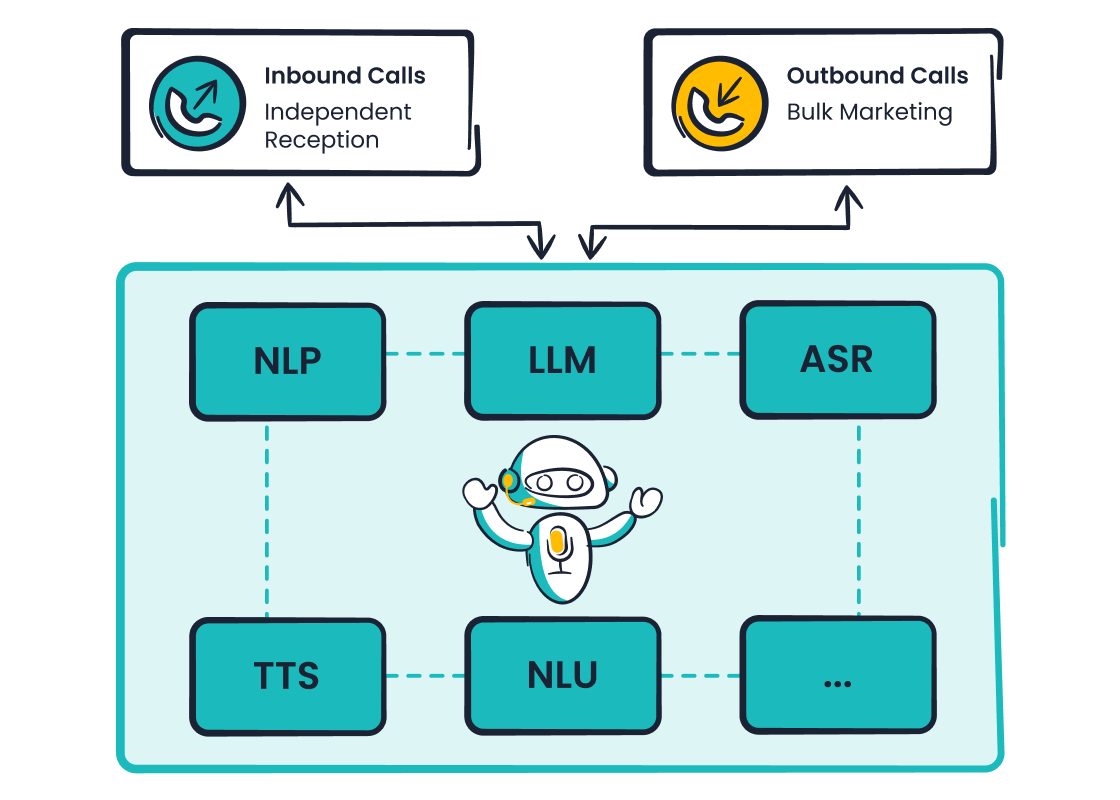
| Voice Bot Platform | Best For | Key Feature |
|---|---|---|
| Sobot Voicebot | Customer Experience, Retail, E-Commerce | Multilingual, seamless integration |
| Lindy | Call Centers | Advanced workflow automation |
| Vapi | Small Businesses | Fast deployment, easy setup |
| Synthflow | E-Commerce | AI-powered product recommendations |
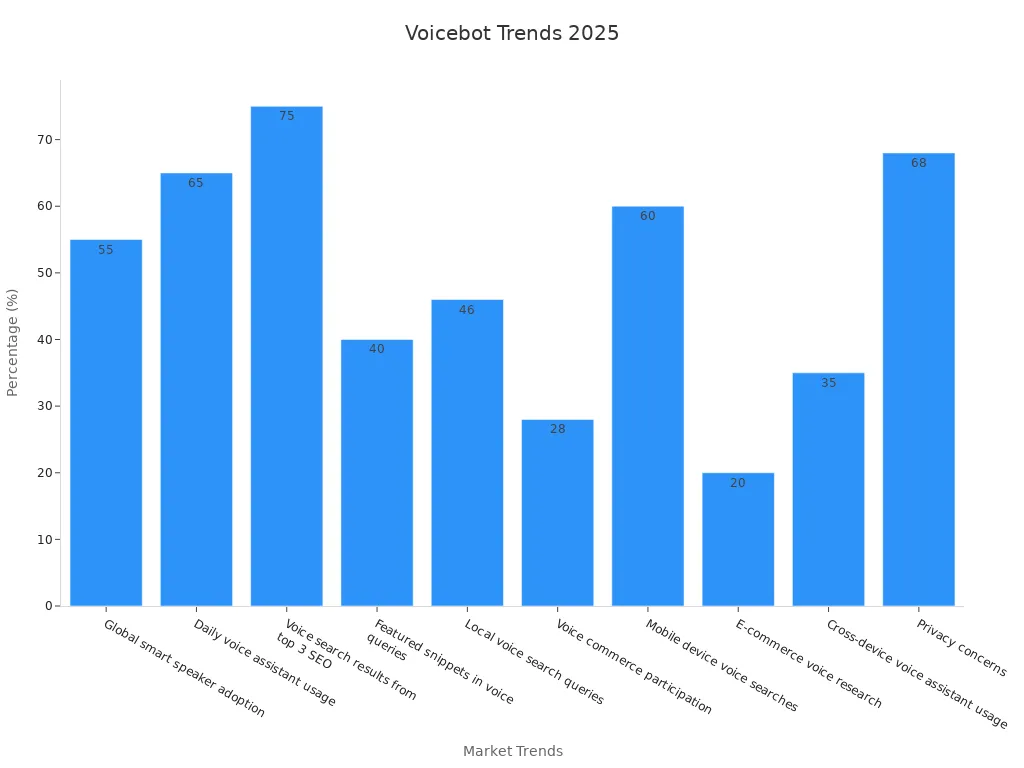
Voicebot platforms now power 65% of daily interactions for adults aged 25–49, with over 8 billion voice-enabled devices in use worldwide. Businesses see up to 80% lower operational costs and 75% higher customer satisfaction by adopting AI voice bot solutions. Sobot AI delivers these benefits by integrating artificial intelligence into voicebots, improving both customer experiences and operational efficiency. Each business should assess its unique needs before selecting a voicebot that aligns with its goals.
Top Voicebots of 2025
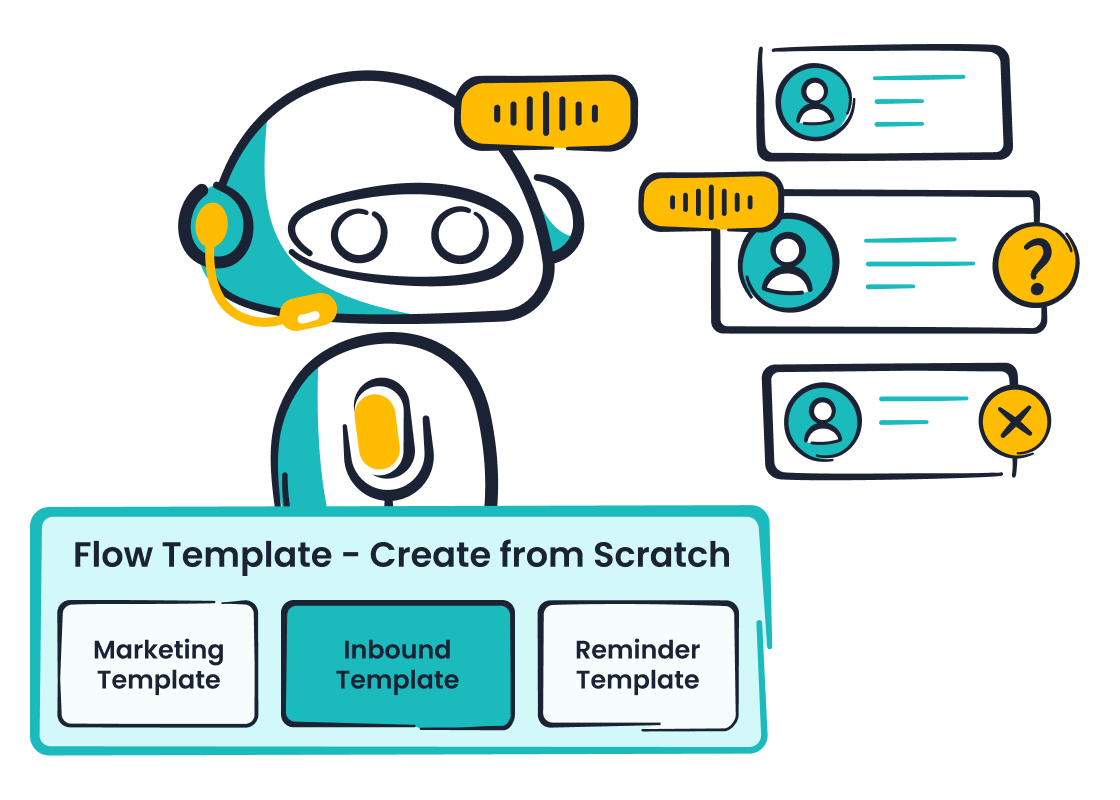
Best Overall AI Voice Bot Solution
AIMultiple ranks voice bot platforms using a transparent, multi-dimensional approach. The evaluation considers customer satisfaction, market presence, growth, and features. These metrics rely on public data, customer reviews, and company profiles. The following table shows independent review counts for leading platforms:
| Platform | Customer Ratings Count | Source of Reviews |
|---|---|---|
| ElevenLabs | 4 | SourceForge |
| IBM watsonx Assistant | 1 | SourceForge |
| Mindsay | 1 | SourceForge |
| Kore.ai | 1 | SourceForge |
| Aisera | 1 | SourceForge |
| Dialogflow | 4 | SourceForge |
| AI Rudder | 4 | SourceForge |
| Herbie.ai | 2 | SourceForge |
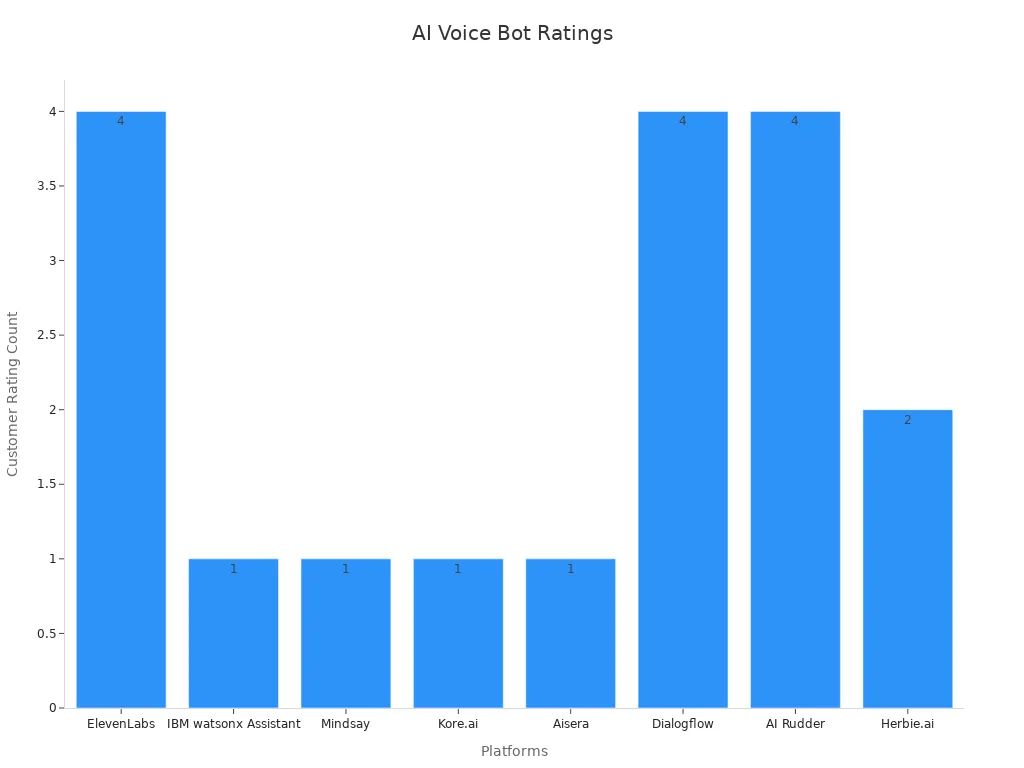
Sobot Voicebot stands out as a best ai agent platform for its seamless integration, multilingual support, and robust ai voice bot solutions. Businesses benefit from its scalable ai agent platforms and advanced voice-first ai agent capabilities, making it a leader among voice bot platforms.
Best for Customer Experience
Voicebots transform customer experience by delivering fast, accurate, and human-like interactions. Metrics such as CSAT, NPS, completion rate, and first call resolution rate measure success. The Bot Experience Score (BES) offers a comprehensive view by tracking negative engagement signals, including repetition and conversation abandonment. High-performing ai voice bot solutions like Sobot Voicebot achieve high CSAT and NPS, reduce average handling time, and increase user retention. These platforms ensure agents can focus on complex issues, while ai-powered assistants handle routine support, improving overall customer experiences.
Best for Call Centers
Voice bot platforms play a vital role in modern call centers. They automate outbound sales, lead qualification, and appointment setting. For example, Convin’s AI voicebot manages multilingual conversations and supports compliance with strict security standards. In a recent case, the MONETA Money Bank voicebot handled 25% of customer calls, saving 471 agent hours in three months. Agents benefit from reduced routine tasks, while customers enjoy shorter wait times and efficient support. Sobot Voicebot enhances call center operations by integrating with CRM systems and providing 24/7 support, allowing agents to focus on high-value interactions.
Best for Ecommerce
Ecommerce businesses rely on ai voice bot solutions to boost sales and customer satisfaction. Voice commerce has grown rapidly, with 22% of US smart speaker owners making purchases by voice. Companies using voicebot platforms report a 10x jump in conversion rates, a 27% boost in CSAT, and a 60% reduction in operational costs. Sobot Voicebot supports ecommerce by automating order inquiries, providing personalized recommendations, and enabling agents to handle complex requests. Brands like Weee! have improved agent efficiency by 20% and reduced resolution time by 50% using Sobot’s ai agent platforms.
- Bank of America saw a 26% increase in customer satisfaction after adding voice-activated services.
- Sephora’s voice assistant increased average order value by 35%.
Best for Small Businesses
Small businesses need cost-effective, easy-to-use voice bot platforms. Alexa leads this segment, with 48% of SMB marketers identifying it as the top choice for marketing potential. Over 60% of SMB marketers already use voice technology, and 53% say better ROI insight would drive further investment. Voicebots help small businesses save time and money, automate customer support, and improve agent productivity. Sobot Voicebot offers scalable ai agent platforms and plug-and-play integrations, making it accessible for businesses of any size.
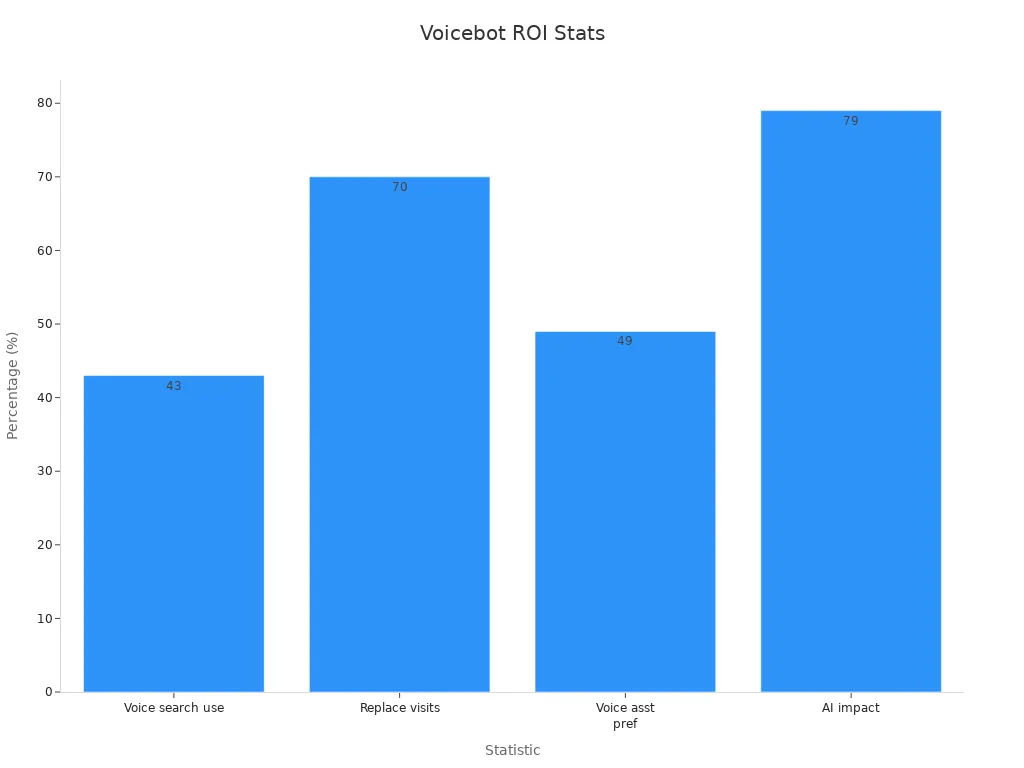
Evaluation Criteria for AI Voice Bot Solutions
NLP and Speech Recognition
Natural language processing forms the backbone of conversational ai and conversational ai solutions. High-quality speech recognition ensures that voicebots understand users across accents, dialects, and noisy environments.
- Deep learning models like DNNs and RNNs have replaced older systems, improving accuracy and context understanding.
- Systems trained on diverse voices adapt better to real-world customer support scenarios.
- Ongoing updates help voicebots keep up with new slang and changing language patterns.
- Accurate speech analytics improve compliance and customer satisfaction in call centers.
Sobot Voicebot uses advanced natural language processing and artificial intelligence to deliver reliable, real-time support for global businesses.
Integrations and APIs
Seamless integration with existing systems is essential for customer service automation. APIs allow voicebots to connect with CRM, ticketing, and ecommerce platforms.
- Companies like Branch and Chợ Tốt have reduced costs and improved innovation by adopting flexible API management.
- Integrated digital ecosystems, as seen in telecom case studies, streamline operations and enhance customer experience.
Sobot Voicebot offers plug-and-play integrations, making it easy for businesses to unify their support channels and scale conversational ai solutions.
Security and Compliance
Security and compliance protect sensitive customer data and build trust.
- Certifications such as GDPR, CCPA, SOC 2, HIPAA, and ISO 27001 set industry standards for privacy and security.
- Leading platforms maintain 24/7 incident management and transparent data practices.
- Regular audits and clear privacy policies ensure ongoing compliance.
Sobot prioritizes data protection, supporting businesses in regulated industries like finance and healthcare.
| Certification | Description |
|---|---|
| GDPR | EU data protection and privacy rights |
| SOC 2 | Security, availability, confidentiality, privacy controls |
| ISO 27001 | Risk-based information security management |
Scalability and Performance
Scalability ensures that conversational ai solutions handle peak loads, such as holiday sales or viral campaigns.
- Key metrics include response time, throughput, latency, and error rate.
- Companies like Amazon test their systems with thousands of virtual users to prepare for high-traffic events.
- Early detection of bottlenecks improves user experience and saves costs.
Sobot Voicebot scales quickly, supporting millions of daily interactions without sacrificing performance.
Pricing and ROI
Affordable pricing and strong ROI drive adoption of conversational ai.
- Subscription models offer predictable costs and broad access.
- Value-based pricing aligns with customer benefits, such as time saved and risk reduction.
- Key ROI metrics include ARPU, CLTV, and CAC.
- Transparent communication of value, like a 20% reduction in handling time, supports pricing decisions.
Sobot Voicebot helps businesses reduce cost-per-contact by up to 80%, maximizing the return on investment.
Customer Satisfaction
Customer satisfaction remains the ultimate measure of success for conversational ai solutions.
- Net Promoter Score (NPS) surveys ask customers how likely they are to recommend a service, with scores above 30 considered great.
- NPS and CSAT scores provide clear benchmarks for loyalty and service quality.
- Regular feedback helps companies refine their support strategies.
Sobot Voicebot consistently delivers high customer satisfaction, as seen in case studies like Weee!, where CSAT reached 96%.
AI-Based Voicebot Comparison
Feature Comparison Table
Selecting the right voice bot platforms requires a clear understanding of their features and capabilities. The table below compares Sobot Voicebot, Lindy, Vapi, and Synthflow across essential categories for customer contact, support, and ecommerce.
| Platform | NLP & ASR | Multi-language | Integration | No-code Builder | Real-time Analytics | Voice/Chat/IVR | Pricing Model | Notable Features |
|---|---|---|---|---|---|---|---|---|
| Sobot Voicebot | ✔️ | ✔️ | ✔️ | ✔️ | ✔️ | ✔️ | Tiered | Human-AI handoff, 24/7 support |
| Lindy | ✔️ | ✔️ | ✔️ | ✔️ | ✔️ | ✔️ | Usage-based | Advanced workflow automation |
| Vapi | ✔️ | ❌ | ✔️ | ✔️ | ✔️ | ✔️ | Freemium | Fast deployment, easy setup |
| Synthflow | ✔️ | ✔️ | ✔️ | ✔️ | ✔️ | ✔️ | Custom | AI-powered product recommendations |
Note: All platforms offer core conversational ai features such as natural language processing, automatic speech recognition, and text-to-speech synthesis. Sobot Voicebot stands out for its seamless integration with CRM and contact center systems, as well as its robust multilingual support.
Key feature categories include:
- Natural Language Processing (NLP)
- Automatic Speech Recognition (ASR)
- Text-to-Speech (TTS)
- Conversational analytics
- Contextual understanding
- Multi-language support
- Integration with enterprise tools
- No-code customization
- Real-time reporting
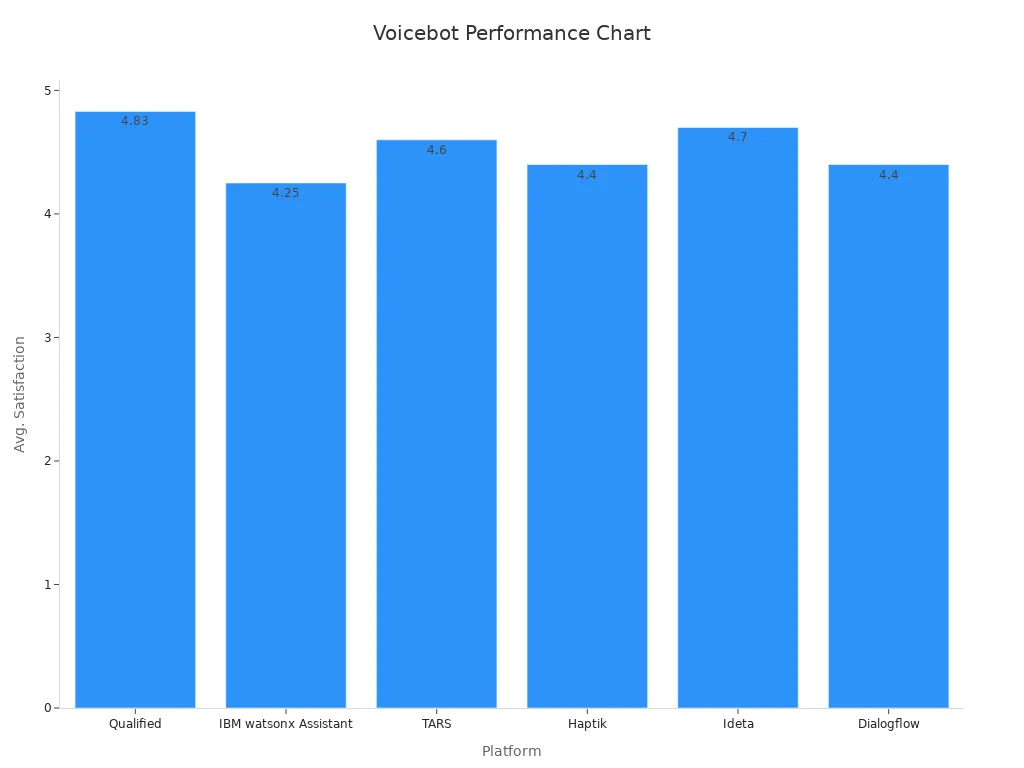
Pros and Cons
Voicebots deliver significant value for businesses, but each platform has unique strengths and limitations. Here is a summary of the main pros and cons for ai agent platforms:
Pros:
- Enable hands-free conversations and multitasking, improving accessibility for users with limited digital skills.
- Reduce call center costs and scale customer support 24/7.
- Automate repetitive tasks, allowing agents to focus on complex issues.
- Offer fast deployment and easy integration with existing systems.
- Support multiple languages, expanding reach to global customers.
Cons:
- Require advanced voice interfaces for more natural conversations.
- Emotional awareness remains a challenge; current voicebots may not detect or respond to emotions effectively.
- Speech recognition errors can impact reliability and user experience.
- Ongoing development needed to improve contextual understanding.
A recent clinical trial of a voice-based virtual coach highlighted these points, showing strong user satisfaction but also identifying areas for improvement in natural conversation and contextual support.
Unique Features
Each voicebot platform brings unique features to the table, enhancing their value for different business needs:
-
Sobot Voicebot:
- Human-like conversational ai with seamless agent handoff.
- Multilingual support for global customer bases.
- Visual flow builder and no-code template setting for rapid deployment.
- Plug-and-play integration with CRM and contact center systems.
- 24/7 operation with scalable performance, supporting millions of daily interactions.
-
Lindy:
- Advanced workflow automation for complex business processes.
- Strong contextual understanding and session management.
-
Vapi:
- Fast deployment and easy setup, ideal for small businesses.
- Freemium pricing model for cost-sensitive users.
-
Synthflow:
- AI-powered product recommendations for ecommerce.
- Real-time analytics and reporting tools for sales optimization.
Businesses should evaluate these unique features in the context of their own customer support and operational requirements.
Use Cases by Industry
Voicebots have transformed customer contact and support across multiple industries. The table below highlights key use cases and outcomes:
| Industry | Use Cases / Implementations | Supporting Statistics / Outcomes |
|---|---|---|
| Healthcare | Appointment scheduling, symptom triage, reminders, accessible reports | Usage rose from 7.5% to 21% of U.S. adults (2020-2021); improves routine healthcare tasks |
| Banking | Credit card management, billing, financial tips, transactions | AI voicebot Keya improved phone banking, simplified commands, and increased customer satisfaction |
| Insurance | Automated claim registration, policy updates, multi-language support | Edelweiss General Insurance bot available 24/7 in 3 languages, automates claims and customer communication |
| Retail | Product recommendations, order tracking, returns, voice assistants for customers/employees | Flipkart voice assistant supports mixed-language commands; Walmart’s “Ask Sam” aids employees in 5000+ stores |
| Manufacturing | Hands-free machinery operation, multi-language recognition, improved efficiency | BSH’s voice control solution increased production efficiency and reduced costs |
Sobot Voicebot has demonstrated strong results in retail and ecommerce. For example, Weee! improved agent efficiency by 20% and reduced resolution time by 50% after implementing Sobot’s ai-based voice bot solution. In banking and insurance, voice-enabled chatbots streamline transactions and automate claim processing, while in manufacturing, voicebots support hands-free operations and boost productivity.
Tip: Companies should match their choice of voicebot to their industry’s specific needs, focusing on features that enhance agent productivity and customer satisfaction.
Sobot Voicebot in Action
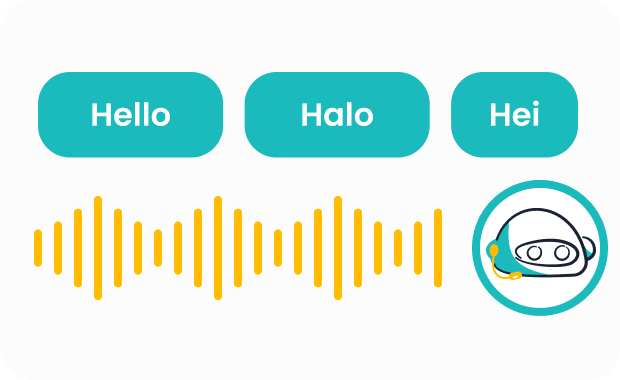
Product Overview
Sobot Voicebot delivers a comprehensive solution for businesses seeking to modernize customer interactions. The platform integrates multiple communication channels, including chat, email, voice, and social media, into a single workspace. Companies benefit from a Robot Task Report, which allows detailed tracking of outbound robot task data. This feature improves task management and team collaboration. The message push service provides both real-time and offline transcription data, enabling enterprises to monitor call events and enhance the intelligent processing of call content. The transfer-to-agent node supports variable-based transfers, ensuring customers connect with the right agent for their needs.
- Sobot’s all-in-one contact center solution eliminates the need for multiple systems.
- The AI-First strategy, launched in 2024, includes omnichannel AI, scenario-based AI, multi-faceted AI (agent, copilot, insight), generative AI powered by multiple LLMs, and secure AI for data privacy.
- Over 10,000 brands across industries such as retail, finance, and gaming trust Sobot, including Samsung, OPPO, and OnePlus.
- Voicebot solutions have gained popularity in Southeast Asia, Asia Pacific, and the Middle East.
- Sobot supports both large enterprises and startups with timely service and competitive pricing.
- Real-time analytics helped a retail company reduce average call handling time by 35%, boosting efficiency and customer satisfaction.
- Sentiment analysis enabled a tech support firm to increase positive customer feedback by 20% within three months.
- Clients praise the user-friendly interface and impactful results, with faster issue resolution and improved service quality.
- The real-time feedback feature acts as a "game-changer" for agents, providing coaching during calls.
Sobot Voicebot stands out as a voice-first ai agent platform, offering businesses a unified, intelligent, and scalable approach to customer engagement.
Key Features and Advantages
| Feature Category | Details |
|---|---|
| Technical Features | Real-time speech recognition (ASR), natural language processing (NLP), large language models (LLM), text-to-speech (TTS) |
| Performance | Handles over 50% of inbound customer interactions independently; improves outbound sales by over 30% through automated marketing |
| Customer Feedback | Recognized as intelligent, human-like, and capable of resolving issues independently; customers appreciate effective guidance |
| Omnichannel Capability | Supports chat, email, voice, and social media for a seamless experience across all channels |
| AI Technology | Integrates multiple advanced LLMs (ChatGPT, Claude, DeepSeek) for high accuracy and low hallucination rates |
| Scenario-Based AI | Tailored for industries like retail and e-commerce, covering pre-sales, checkout, and post-sales support |
| Multi-Faceted AI | Assists customers, agents (copilot), and administrators (insights) |
| Security and Compliance | Meets global data privacy standards with regional data centers and certifications |
| Customer Experience | AI agent understands language nuances and recommends intelligently based on keywords, delivering differentiated experiences |
Sobot Voicebot leverages advanced AI to deliver real-time speech recognition and natural language understanding. The platform independently manages over half of inbound customer interactions, freeing agents to focus on complex cases. Automated outbound marketing increases sales by more than 30%. The omnichannel capability ensures customers receive consistent support, whether they reach out via chat, email, voice, or social media. Sobot’s AI-powered assistants provide agents with real-time coaching and actionable insights, improving performance and customer satisfaction.
Sobot’s multi-faceted AI supports not only customers but also agents and administrators, making it a powerful tool for any organization.
Customer Story: Weee!
Weee!, America’s largest online Asian supermarket, faced challenges with inflexible IVR systems and language barriers. The company needed a solution to handle high volumes of customer inquiries and support a diverse customer base. Sobot Voicebot provided a flexible IVR system, integrated workbench, and multilingual support.
- After implementation, agent efficiency increased by 20%.
- Resolution time dropped by 50%.
- The customer satisfaction score reached 96%.
Weee! benefited from Sobot’s open API, which allowed seamless integration with their ticketing system. Agents managed communications from various channels in one place, improving information synchronization. The flexible IVR and multilingual templates enabled agents to serve customers across different regions and time zones. Weee! praised the user-friendly interface and the significant improvements in service quality.
“The real-time feedback feature was a game-changer for our agents,” said a Weee! representative, highlighting the impact on both efficiency and customer experience.
Industry Applications
Sobot Voicebot adapts to the needs of various industries, delivering measurable results:
- Retail and E-Commerce: Automates order inquiries, provides personalized recommendations, and supports customers throughout the buying journey. Companies see reduced cart abandonment and higher conversion rates.
- Finance and Banking: Handles routine transactions, account management, and compliance-related queries, ensuring secure and efficient service.
- Gaming and Entertainment: Manages player support, event notifications, and community engagement, enhancing user satisfaction.
- Enterprise Services: Streamlines internal support, automates HR inquiries, and improves agent productivity.
- Healthcare: Schedules appointments, sends reminders, and provides accessible reports, improving patient engagement.
Voicebots powered by Sobot’s AI technology help organizations reduce operational costs, improve agent efficiency, and deliver superior customer experiences. The platform’s flexibility and scalability make it suitable for both large enterprises and growing startups.
Companies across industries choose Sobot Voicebot for its reliability, advanced AI, and proven ability to transform customer service operations.
Choosing the Right Voicebot
Business Size and Needs
Selecting a voicebot starts with understanding business size and operational needs. Small businesses often benefit from solutions that offer easy setup and low maintenance. These companies may prioritize fast deployment and cost-effectiveness. Larger enterprises require advanced features, such as deep integration with CRM systems and robust analytics. They also need scalable platforms that can handle high call volumes and complex workflows. Voicebots enable hands-free, natural interactions, making them ideal for multitasking and accessibility. Decision-makers should consider the complexity of tasks, the number of daily interactions, and the need for 24/7 support. Sobot Voicebot adapts to both small and large organizations, providing scalable solutions that grow with business demands.
Industry Considerations
Different industries have unique requirements for voicebot platforms. Retail and e-commerce companies often need multilingual support and personalized recommendations. Healthcare providers look for secure solutions that manage appointments and reminders. Financial services demand strict compliance and data privacy. The following table highlights how input methods and dialogue complexity vary across solutions:
| Feature | Traditional IVR | Voicebot | Conversational IVR |
|---|---|---|---|
| Input Method | Touch-tone, Basic Keywords | Simple Voice Commands | Natural Language Speech |
| Dialogue Complexity | Rigid Menu Tree | Single-Intent Tasks | Multi-turn, Contextual Flows |
| Ideal Use Case | Call Routing | FAQs, Simple Tasks | Complex Self-Service & Automation |
Sobot Voicebot supports a wide range of industries, offering scenario-based AI and compliance with global standards.
Technical Resources
Technical resources play a key role in voicebot selection. Voicebots require advanced speech recognition and ongoing data management. Businesses with strong IT teams can customize and maintain complex systems. Companies with limited technical staff may prefer platforms with no-code builders and plug-and-play integrations. Sobot Voicebot offers a visual flow builder and easy integration, reducing the need for specialized skills. The platform’s AI agent assists with setup and ongoing optimization, making it accessible for organizations of all sizes.
Tip: Evaluate available IT resources before choosing a voicebot. Platforms with user-friendly interfaces and strong support can help teams succeed without heavy technical investment.
Budget and Value
Budget and value drive many voicebot decisions. Voicebots often require higher upfront investments but deliver significant long-term savings. For example, a mid-sized health insurance provider reduced cost per interaction by 42% and improved member satisfaction by 18% after deploying a voicebot. Companies report that voicebots typically pay for themselves within 6–12 months. Development costs vary, with small business solutions ranging from $50,000 to $200,000. Smart budget planning and clear goals maximize ROI. Sobot Voicebot helps organizations reduce operational costs while improving agent productivity and customer satisfaction. Customer service automation further enhances value by scaling support during peak periods and maintaining consistent quality.
Voicebots and Customer Experience Trends
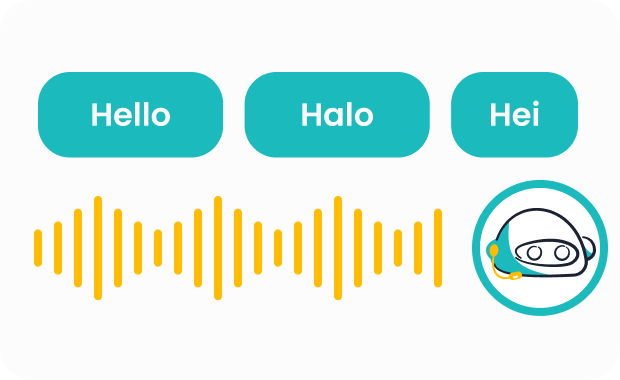
AI Voice Bot Solutions in 2025
AI voice bot solutions continue to shape the future of customer experience. Businesses across industries now rely on voice-driven experience platforms to automate support, personalize interactions, and improve efficiency. Several trends stand out for 2025:
- The chatbot market is projected to grow by $1.43 billion by 2025, showing rapid adoption in retail, healthcare, and finance.
- Gartner predicts conversational AI will automate 10% of agent interactions, reducing contact center labor costs by $80 billion by 2026.
- 65% of businesses plan to expand AI use in customer experience within the next year.
- AI-driven sentiment analysis is gaining traction, providing real-time emotional insights from customer conversations.
- Companies invest in multilingual support and automated conversation summaries to boost engagement and efficiency.
Sobot Voicebot exemplifies these trends. Its platform offers multilingual support, real-time analytics, and seamless integration with existing systems. Sobot’s AI-driven communication tools help organizations deliver consistent, high-quality customer experiences across channels. The platform’s continuous learning and automation capabilities position it as a leader in the future of ai-driven communication.
Future of Customer Experience
The future of customer experiences will see even greater transformation as technology advances. Generative AI will enable voicebots to provide creative, context-aware responses, with conversation success rates expected to reach 99% by 2027. Emotional intelligence will allow voicebots to interact empathetically, improving satisfaction and loyalty. Multimodal capabilities, such as combining voice and visual elements, will personalize each interaction.
| Aspect | Details |
|---|---|
| Market Size Forecast | USD 7.97B (2024) to USD 54.64B (2034), CAGR 22.51% |
| Key Trends | Human-like voicebots, smart device integration, omnichannel support |
| Market Drivers | AI/ML adoption, automation demand, improved accessibility |
| Opportunities | Personalized engagement, IoT integration, healthcare applications |
Sobot’s solutions already reflect these future trends. The platform leverages advanced NLP, voice biometrics, and real-time translation to deliver secure, scalable, and personalized support. As organizations adopt these innovations, they can expect significant ROI and a competitive edge in customer service. The future of ai-driven communication will empower businesses to automate up to 99% of interactions, reduce costs, and deliver a truly voice-driven experience.
Voicebot platforms continue to transform customer service and ecommerce. Sobot Voicebot stands out for its multilingual support, seamless integration, and proven results, such as Weee!’s 20% boost in agent efficiency. Businesses can use the evaluation criteria and comparison tables to select the best ai voice bot solutions for their needs.
- Review key findings on voicebot platforms, including data sources and challenges.
- Validate and standardize information before making decisions.
- Explore case studies like Sobot Voicebot’s impact on customer satisfaction.
- Consider future trends and implications for ai voice bot solutions.
For more details or to request a demo, contact Sobot at marketing@sobot.io. Share your feedback or explore Sobot Voicebot’s solutions at sobot.io.
FAQ
What is the difference between a voicebot and a chatbot?
A voicebot interacts with users through spoken language, while a chatbot uses text. Many businesses use both to improve customer service. For example, Sobot Voicebot handles phone calls, and Sobot Chatbot manages website chats. Both solutions help companies automate support and save time.
How does Sobot Voicebot improve customer satisfaction?
Sobot Voicebot uses advanced AI to answer questions quickly and accurately. Companies like Weee! saw a 96% customer satisfaction score after using Sobot. The voicebot reduces wait times and provides support in multiple languages, which helps customers feel valued.
Can Sobot Voicebot integrate with existing systems?
Yes. Sobot Voicebot connects with CRM and contact center systems using APIs. This integration allows businesses to manage all customer interactions in one place. Companies can track calls, automate tasks, and improve team efficiency without changing their current setup.
Is Sobot Voicebot secure and compliant?
Sobot Voicebot meets global data privacy standards, including GDPR and ISO 27001. The platform uses data encryption and regional data centers to protect customer information. Regular audits and strong security practices help businesses in finance, healthcare, and retail stay compliant.
When should a business choose a voicebot vs chatbot?
A business should choose a voicebot for phone-based support or when customers prefer speaking. A chatbot works best for website or app chats. Many companies use both to cover all channels. Sobot offers both options, making it easy to provide seamless customer service.
See Also
Best Website Chatbots To Use In 2024 Ranked
Leading Websites Featuring Chatbots Throughout 2024
Reviewed Best Automated Voice Calling Tools For 2024
